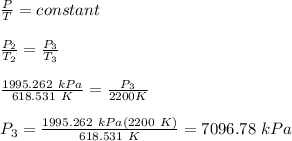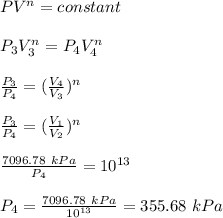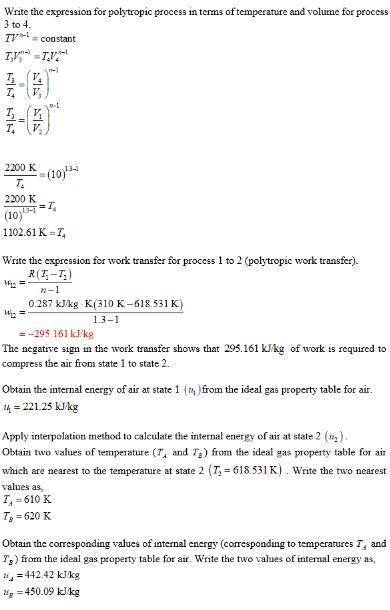
Engineering, 25.02.2020 23:57 karlacr5117
Consider a modification of the air-standard Otto cycle in which the isentropic compression and expansion processes are each replaced with polytropic processes having n = 1.3. The compression ratio is 10 for the modified cycle. At the beginning of compression, p1 = 1 bar and T1 = 310 K. The maximum temperature during the cycle is 2200 K. Determine
(a) The heat transfer and work in kJ per kg of air for each process in the modified cycle.
(b) The thermal efficiency.
(c) The mean effective pressure, in bar.

Answers: 2


Other questions on the subject: Engineering

Engineering, 03.07.2019 14:10, BardiFan
Amass of m 1.5 kg of steam is contained in a closed rigid container. initially the pressure and temperature of the steam are: p 1.5 mpa and t 240°c (superheated state), respectively. then the temperature drops to t2= 100°c as the result of heat transfer to the surroundings. determine: a) quality of the steam at the end of the process, b) heat transfer with the surroundings. for: p1.5 mpa and t 240°c: enthalpy of superheated vapour is 2900 kj/kg, specific volume of superheated vapour is 0. 1483 m/kg, while for t 100°c: enthalpy of saturated liquid water is 419kj/kg, specific volume of saturated liquid water is 0.001043m/kg, enthalpy of saturated vapour is 2676 kj/kg, specific volume of saturated vapour is 1.672 m/kg and pressure is 0.1 mpa.
Answers: 3

Engineering, 04.07.2019 18:10, johnthienann58
Thermal stresses are developed in a metal when its a) initial temperature is changed b) final temperature is changed c) density is changed d) thermal deformation is prevented e) expansion is prevented f) contraction is prevented
Answers: 2

Engineering, 04.07.2019 18:20, rjone8429
Asimple rankine cycle uses water as the working fluid. the water enters the turbine at 10 mpa and 480c while the condenser operates at 6 kpa. if the turbine has an isentropic efficiency of 80 percent while the pump has an isentropic efficiency of 70 percent determine the thermal efficiency
Answers: 1

Engineering, 06.07.2019 03:10, kturvey225
Consider a 1.2 meter high and 2 meter wide glass window whose thickness is 6 mm and thermal conductivity is 0.78 w/m °c. the room temperature is maintained at 24 °c, while the outdoor temperature is -5 °c. the convective heat transfer coefficients on the inner and outer surfaces of the window are 10 w/m2 °c and 25 w/m2 °c respectively. (a) draw the thermal resistance network, etermine the steady rate of heat transfer t e glass window (c) determine the temperature of the inner surface of the window
Answers: 3
You know the right answer?
Consider a modification of the air-standard Otto cycle in which the isentropic compression and expan...
Questions in other subjects:



















 Therefore p₂ = p₁ ÷
Therefore p₂ = p₁ ÷  = (1 bar) ÷
= (1 bar) ÷  = 19.953 bar
= 19.953 bar or T₂ = T₁ ÷
or T₂ = T₁ ÷  =
=  = 618.531 K
= 618.531 K = 0.287 kJ/kg⋅K
= 0.287 kJ/kg⋅K =
=  = 295.16 kJ/kg
= 295.16 kJ/kg =
=  = -73.79 kJ/kg
= -73.79 kJ/kg = Where T₄ is given by
= Where T₄ is given by  or T₄ = T₃ ×
or T₄ = T₃ ×
 = -1049.835 kJ/kg
= -1049.835 kJ/kg =
= = 0.499 or 49.9 % Efficient
= 0.499 or 49.9 % Efficient![p_{m} = \frac{p_1r[(r^{n-1}-1)(r_p-1)]}{ (n-1)(r-1)}](/tpl/images/0524/0182/a7463.png) where r = compression ratio and
where r = compression ratio and  =
= 
 =
= =70.97 atm
=70.97 atm
![p_m =\frac{1*10*[(10^{0.3}-1)(3.56-1)]}{0.3*9}](/tpl/images/0524/0182/fb52e.png) = 9.44 bar
= 9.44 bar






